Observe the given figure carefully.
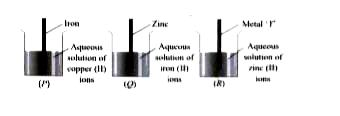
Select the correct statement(s) from the following.
I. In beaker 'P', blue colour of solution changes to green colour.
II. In beaker 'Q', no reaction takes place.
IIl. In beaker' R', if' Y' is aluminium then reaction will take place.
IV. In beaker 'R', if ' Y' is tin then reaction will take place.
I only
II and IV only
I and III only
I, II, Ill and IV
The correct Answer is:C
In beaker .Q., reaction will take place as zinc being more reactive than iron displaces iron from aqueous solution of iron (II) ions.
In beaker .R., if .Y is tin then no reaction will take place as tin being less reactive than zinc, cannot displace zinc from aqueous solution of zinc (II) ions.
Topper's Solved these Questions
- NSO QUESTION PAPER 2018- 19 SET - ABOOK - SCIENCE OLYMPIAD FOUNDATION CHAPTER - NSO QUESTION PAPER 2018- 19 SET - AEXERCISE - ACHIEVERS SECTION
5 Videos
- NSO QUESTION PAPER 2017-18 SET-BBOOK - SCIENCE OLYMPIAD FOUNDATION CHAPTER - NSO QUESTION PAPER 2017-18 SET-BEXERCISE - SCIENCE
9 Videos
- NSO QUESTION PAPER 2018- 19 SET - BBOOK - SCIENCE OLYMPIAD FOUNDATION CHAPTER - NSO QUESTION PAPER 2018- 19 SET - BEXERCISE - ACHIEVERS SECTION
1 Videos
Similar Questions
Four experimental set-ups are shown in the given figure.
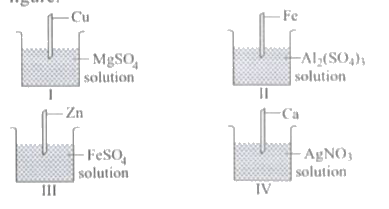
No reaction will take place in beaker(s)
View SolutionObserve the given figure and answer the following questions.
(a) Write the complete balanced reaction for the reaction that takes place.
(b) Type of reaction involved.
(c) Is there any precipitate formed.
(d) If any precipitate formed, write the colour of the precipitate.
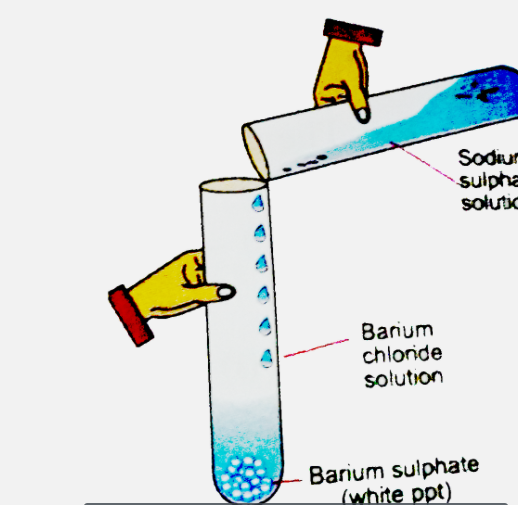
View Solution
Knowledge Check
The following diagram displays a chemical reaction. Observe carefully and answer the questions.
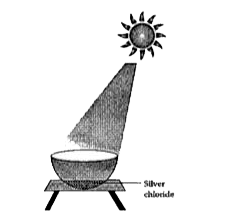
The type of chemical reaction that will take place isAPhotochemical decompositionBDisplacement reactionCReduction reactionDCombination reactionSelect the correct statement out of P, Q and R for zero order reaction.
(P) Quantity of the product formed is directly proportional to time
(Q) Larger the initial concentration of the reactant, greater the half-life period
(R) If 50% reaction takes place in 100 minutes, 75% reaction takes place in 150 minutes.AP onlyBP and Q onlyCQ and R onlyDP, Q and R(A) In SN2 reactions, complete inversion of configuration takes place.
(R) In SN1 reactions, retention but not the inversion takes place,AIf both (A) and (R) are correct and (R) is the correct explanation of (A).BIf both (A) and (R) are correct but (R) is not the correct explanation of (A).CIf (A) is correct but (R) is incorrect.DIF (A) is incorrect but (R) is correct.
When a green iron salt is heated strongly, its colour finally changes to brown and odour of burning sulphur is given out.
Name the type of reaction that takes place during heating of iron salt.
View SolutionThe following diagram displays a chemical reaction. Observe carefully and answer the following questions :
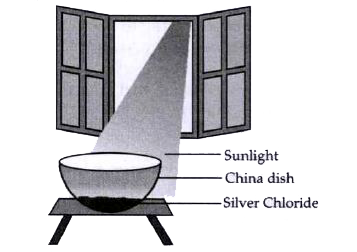
The type of chemical reaction that will take place is :
View SolutionA small amount of a substance X is taken in a beaker and dilute hydrochloric acid is added to it slowly while stirring. The colour of the solution turns blue green.
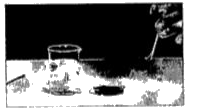
Select the correct statements:
I. The substance X is copper oxide
II. The substance X is iron oxide
III. The blue green colour of the solution is due to the formation of copper chloride.
IV. The blue green colour of the solution is due to the formation of copper sulphate.
View SolutionWhat would you observe when zinc is added to a solution of iron (II) sulphate?
Write the chemical reaction that takes place.
View SolutionWhat would you observe when zinc is added to a solution of iron (II) sulphate?
Write the chemical reaction that takes place.
View Solution
